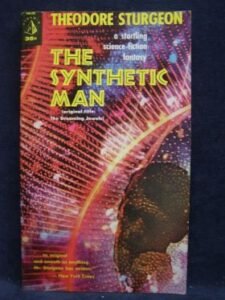The Synthetic Man by Theodore Sturgeon (book review)
‘The Synthetic Man’ was originally released as ‘The Dreaming Jewels’ in 1950. This edition was released in 1961. Half-way through the book, I’m still not sure about the title but it did make sense later.
Horton is a young boy sent home from school for eating brown ants. His step-parents, the Bluetts, are hardly nice people. His step-father, Armand, saw Horty, as useful baggage in his political campaign and now a burden. Banishing Horty to a wardrobe/closet, he slams the door, severing three of the kid’s fingers. Horty flees, after briefly seeing his only friend, Kay Hallowell, what he is doing. Luckily for him, he’s taken in by some dwarves and midgets of a travelling carnival and masquerades as a midget girl for nine years as a performer with midget Zena, wearing gloves to hide his injuries. During this time, his fingers grow back.
Meanwhile, back in his home town, Armand Bluiett, now a judge, has taken a shine for Kay.
What is weird about the mid-point of this story is how Sturgeon suddenly turns everything upside down. ‘The strange people’, the same for the more freaky-looking humans here, work for Pierre Monetre aka Maneater suddenly takes centre stage as, from Bluett’s prompting, to seek out the adult Horty, using his former friends. It seems the only part of Horty’s jack-in-the-box toy Junky’s parts remaining are its eyes…the dreaming jewels. I’m still not sure what exactly Horty is but he can suspend his growth and regenerate his fingers. He ends up having to rescue everyone and goes spoiler.
There is a time when any author is writing a story gets into it and realises its moving in a predictable path but, contractually, has to finish it for deadline. To get out of such jams, you look over the first part and see what you can do to shake it up. When I do my own stories, I write until near the end and stop and consider the ending and how many different solutions I can come up with what I’ve written so far so it makes it difficult for people to anticipate the ending. I’m sure other authors do similar things to avoid cliches. To see Sturgeon doing this some 64 years ago throws some insight a respected SF author having a similar problem. In some respects, because no actual science is applied, this story is probably closer to science-fantasy than his usual fare. A lesson from this is don’t ignore any SF author’s less famous books as there is always something to learn.
GF Willmetts
November 2025
(pub: A Pyramid Book, 1961. 174 page paperback. Price: varies. ISBN: 6636)


